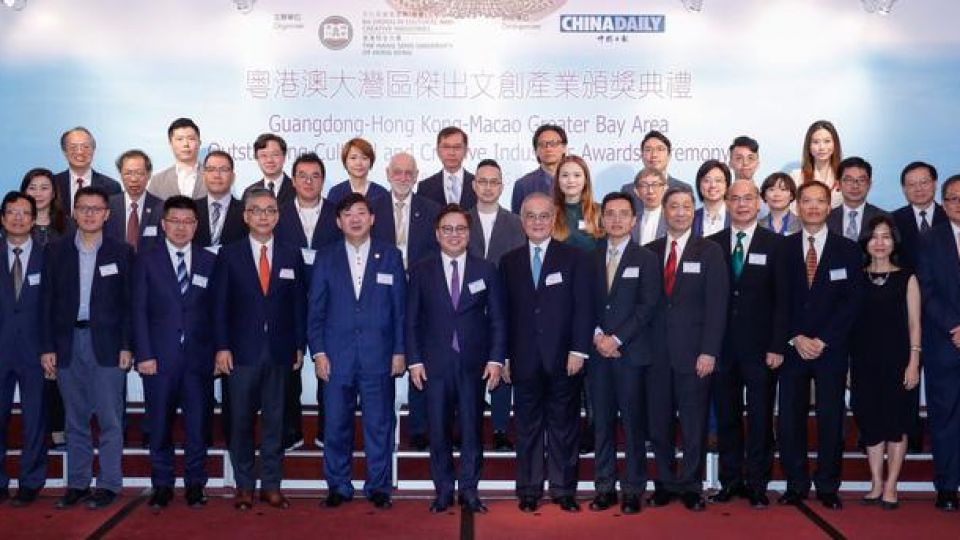September 10, 2019
The awards took place last Friday.
Cultural and creativity industry prizes awarded on Friday highlighted the opportunities inherent in the Guangdong-Hong Kong-Macao Greater Bay Area for cooperation and greater synergies.
The Guangdong-Hong Kong-Macao Greater Bay Area Outstanding Cultural and Creative Industries Awards Ceremony was held in Hong Kong to promote outstanding companies and organizations in the cultural and creative industries within the Bay Area.
Co-organized by Hang Seng University of Hong Kong and China Daily, the event also aimed to raise awareness of the Bay Area and facilitate a deeper understanding of the cultural and creative enterprises in the area.
“The cultural and creative industry is one of the key pillars of China’s economy. Its development, combined with the continuing Bay Area movement, represents huge opportunities for both Hong Kong and Chinese mainland,” said Simon S M Ho, Hang Seng University of Hong Kong president, during the opening remarks.
Moses Cheng Mo-chi, a consultant at Hong Kong law firm Messrs. P.C. Woo & Co, added during his own opening remarks that the Hong Kong government has been advancing development in innovative and cultural industries in recent years, while at the same time facilitating collaboration with China to further push these industries forward.
The comments were echoed by Zhou Li, editorial board member of China Daily Group and publisher and editor-in-chief of China Daily Asia Pacific, who said he saw a lot of potential in the cultural and creative industry.
The Bay Area represents “natural progress that makes sense”, said Wilfred Wong Ying-wai, chairman of the Hong Kong Arts Development Council, in his keynote address for the awards ceremony.
“The Guangdong-Hong Kong-Macao Greater Bay Area has three different currencies, taxing systems and legal infrastructures. The people residing in these areas also have different cultural backgrounds,” Wong said.
“Problems related to exporting issues and the falling yuan might also come into play. Because of that, to fully integrate these three places might take some time,” he added. “But I am a firm believer of ‘harmony in diversity’. We need to adopt an open mind and take benefits from the different innovative ideas.”
Citing the filmmaking industry as an example, Wong noted that most successful movies in Hong Kong rely on music producers from Japan, CGI technologies from South Korea, and actors from Hong Kong and the Chinese mainland.
“The potential success in the GBA (Greater Bay Area) might be the same in that sense. Diversity is key,”Wong said.
Rocco Yim, leader and key architect of Rocco Design Architects Ltd; Kevin Lee, founder and CEO of Redspots Creative (HK) Co Ltd; Elaine Shiu, founder and chief brand officer of Ejj Holding Ltd; and Jeff Tung, senior project director of New World Development Co, took part in a panel discussion titled Cultural and Creative Bay Area: New Development Trends of Cultural and Creative Industries in the Digital Era.
All of them showcased the latest innovations from their companies and shared their thoughts on what the future holds for companies given the opportunities brought about by the growth of the Bay Area.
Lee from Redspots Creative demonstrated 3D video production and augmented reality and virtual reality interactive technologies, products and platforms, as well as motion-capture and facial-expression-capture technologies.
Shiu from Ejj Holdings shared examples of fashion accessories produced using 3D printing technologies. Shiu said her customers are often amazed by the fact that accessories can now be made using 3D printing. She went on to explain that productivity is improved and the design progress is more flexible with such technology. The whole production process is more environmentally friendly too, she said.
“I am proud and delighted to find out Hong Kong designers and their brands received support from the GBA and are gaining more popularity in the area. 3D printing technology is not commonly available in China for fashion jewelry production yet, so there are a lot of opportunities to explore there,” she added.
Tung from New World Development showcased the latest technologies used in the Tsim Sha Tsui area, such as the wave energy demonstrator, a green education tool that is able to produce electricity; and smart light poles, which can perform multiple task, including providing Wi-Fi and electricity for large public events.
Yim from Rocco Design Architects said technologies such as 3D modeling and other related software allow designers to convert the ideas in their mind to quantifiable graphics, which is something not possible previously.
However, he noted that technologies should not “control everything”.
“Technologies should only be used as tools and platforms that enhance performance. I believe designs should come from the human mind and creativity, not computers,” Yim said.
Addressing the issues of how Hong Kong people’s creativity levels compared with their counterparts in the Bay Area, Lee said that while the markets in China are bigger, Hong Kong designers have more exposure to the global world and are able to “learn from the best” from both the Eastern and Western worlds.
“Creativity is in Hong Kong people’s blood,” he said.
Yim said Hong Kong and the Bay Area are very different, but each has its own advantages.
“For example, Hong Kong is limited in terms of land resources. But it is exactly because of this limitation, local designers are able to, or you might say are forced to, come up with unique designs that could only be seen in this city.”
Shiu said that the Bay Area is a bridge that connects local designers to Chinese mainland markets.
Hui Cheuk-kuen, a professor of the Hang Seng University, concluded the event by wishing the Bay Area prosperity, and said he looks forward to next year’s award ceremony.


